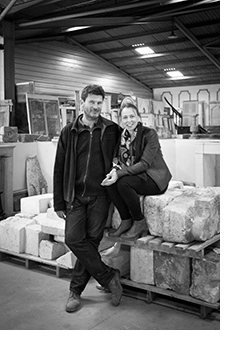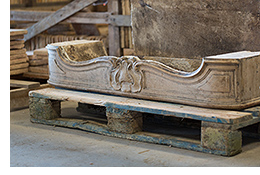en
- English (United States)
- Français (French)
 For many of us, nothing can rival the charm of the old! Whether it is to customise an apartment that lacks a soul or to renovate an old house with respect for its origins, using recovered materials allows you to achieve superb results—sometimes less expensively than buying it new. This approach is not new. People have always recycled elements from earlier times. However, this was mainly done for economical reasons in the past, given the lack of materials, means, and human resources to make new objects. Today, we mainly recycle the old for the aesthetic aspect of the materials and the quality they have acquired over the centuries.
For many of us, nothing can rival the charm of the old! Whether it is to customise an apartment that lacks a soul or to renovate an old house with respect for its origins, using recovered materials allows you to achieve superb results—sometimes less expensively than buying it new. This approach is not new. People have always recycled elements from earlier times. However, this was mainly done for economical reasons in the past, given the lack of materials, means, and human resources to make new objects. Today, we mainly recycle the old for the aesthetic aspect of the materials and the quality they have acquired over the centuries.
Following in the footsteps of his parents, Arnaud Labrouche has specialised in this particular trade. When a house or a castle is to be demolished, he carries out an inventory of everything that can possibly be salvaged (doors, fireplaces, stairs, floors, cobblestones, gates etc.), and buys them from the wrecking company. He then stores his unique finds in Montendre or Aytré where buyers (individuals, interior designers, and architects) come to find exactly what they are looking for. Fireplaces, paving stones, terracotta tiles, wells, porches, stone troughs, and numerous decorative elements fill the two showroom sites.
A first glance lets us immediately understand that nothing is random in the clean and carefully order hangar in Aytré. "Each item purchased is photographed, measured, referenced and listed." More than ten years of work are thus archived—enough to write a book even. ...A thought that has already crossed Arnaud's mind "For the moment, this work is mainly used to replicate certain models, which we recreate identically."
Here, stone fireplaces are numerous. Nothing unusual in a region where the ancient quarries, including Jonzac, Thénac, St Macaire, Crazannes abound... and the quality of the stone is long proven. In particular antique overmantel fireplaces in Saintonge stone, one of the richest in France next to Burgundy stone. The heritage and know-how of several generations of stone cutters are thus rescued from oblivion and destruction.
"Dismantling without damaging the object requires a great amount of technical skill. There is a sense to be respected when disassemble the parts so as to not damage them. Then they need to be numbered in order to be able reassemble in the same order." And since our ancestors already salvaged and renovated antique materials, it just happens that in taking it apart, a genuine wonders appears. "Architectural antiquarians are often poorly perceived if not downright suspected of plundering the cultural heritage" fulminates Valerie Labrouche. "That is just not true" even if the couple acknowledges that their profession has its "black sheep", like any other profession.
 But the family's approach, which persists for two generations already, is based on respect for the past and preservation of a certain savoir-faire.
But the family's approach, which persists for two generations already, is based on respect for the past and preservation of a certain savoir-faire.
"Of course, a number of architectural elements have gone and are sent abroad. However, the passport system that was put in place is very inconvenient, even if it is justified." Furniture and other paintings, which are just as much a part of our heritage, are not required to have it, whereas, the least trough is subject to it. In addition to this, without a big deal being made of it, certain architectural antiquaries engage in corporate philanthropy.
"Some time ago, we found and purchased a small kiosk, which had long been in Gua. We donated it to the commune on the condition that a project be put in place to restore it. And that was done." The same effort was made in Chaunac for a porch, which proves the genuine passion and commitment of the family to the heritage of its native region. Arnaud is committed to respecting the past, even down to the copies of antiques. "There are copies and there are copies. Good work means using ancestral methods as well as respecting the dimensions and proportions of the objects. Then, there is the fineness of the execution that must be observed."
What can be salvaged?
"Almost everything, from roofing to floors, not to mention garden elements such as the basins, troughs, gates, benches, and other sculptures... " responds Valerie. "And as long as they are in good condition, or their restoration is not too expensive" added Arnaud. He makes no secret of the fact that it has become increasingly difficult to find certain items, especially since demolitions are less frequent today given that now, old buildings are more likely to be restored. "But, it happens that because of a lack of time or by ignorance of the value of things, architectural elements are simply destroyed. The owners, especially when it comes to SCI real estate rarely ask to an architectural antiquarian to take a look before carrying out any work." It is a shame, because thanks to their historical knowledge, these professionals can accurately date architecture elements, give an idea of their value or detect a copy. And then recover and give a second life to those things, which is more environmentally friendly. The salvaging effort goes against diehard consumerism. "And the materials that we have, like these hand-made terracotta tiles, have nothing chemical about them."
And these fireplaces, tiles, doors, or porches will never cease to whisper stories in our ear, their own personal stories...
Article published in "Maison d'océan"

Follow us